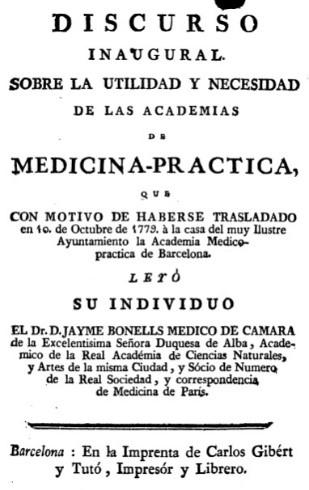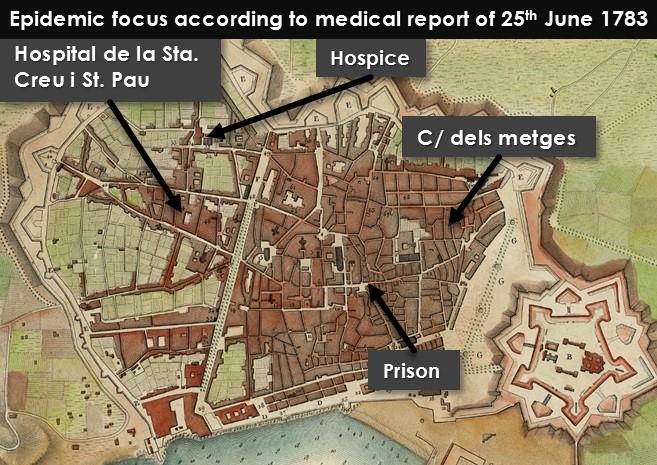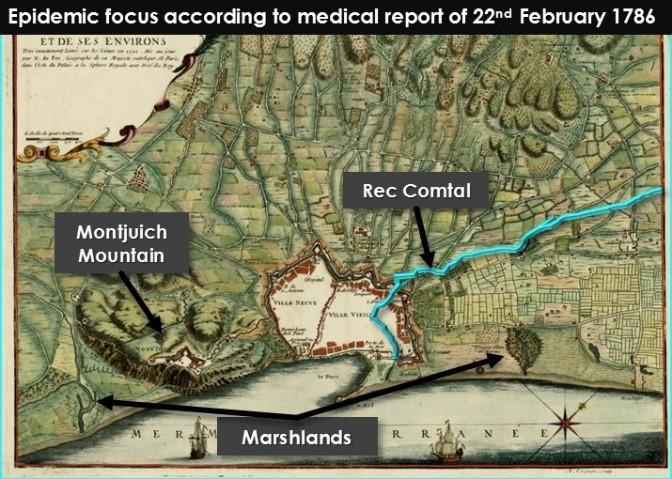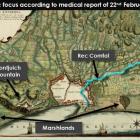The Barcelona malarial epidemic of 1783 to 1786 was part of an ongoing peninsular-scale epidemic that affected one million people and caused 100,000 deaths, with drastic demographic consequences for Spanish society. Fever, chills, and sweat are the most common symptoms of malaria. Generally, people affected by the disease exhibit these symptoms over three or four days. The contemporary term “tertian fevers” served to denominate a wide range of diseases (fevers, agues, and intermittent fevers) that had common symptoms, which can now be linked to the illness known as malaria. This paper focuses on the reaction of sanitation professionals and the development of specific sanitation policies that could have been systematically implemented by Barcelona’s local authorities.
Before the 1783–1786 epidemic, the problems of Barcelona’s landscape were well known to its local authorities and physicians. The development of intensively irrigated agriculture, the presence of textile cotton factories on Barcelona’s periphery, and the existent hydro-geomorphological conditions strongly favored the proliferation of unhealthy areas. Malaria is sensitive to changes in temperature and precipitation, and the climatic context at that time was determined by the Maldà oscillation (1760–1800), a meteorological phenomenon characterized by extreme and catastrophic floods, snow, storms, and dry periods. These changes probably had a direct impact on the presence of epidemic malaria and caused the disease to travel beyond its traditional endemic areas.
The political and administrative context of Barcelona at the time reveals the lack of influence physicians had over municipal authorities. The administrative centralization imposed by King Philip V in 1717 following the War of Spanish Succession resulted in the Real Decreto de Nueva Planta, a decree which introduced major changes in traditional municipal institutions. The municipality of Barcelona saw its budget reduced to one-quarter of its previous levels, a noticeable reduction in the city’s autonomy over decision-making, and a drastic diminution of the presence of physicians on the city council. In addition, the suppression of traditional medical institutions such as the Estudi General (Barcelona’s medical school) and the University of Barcelona forced physicians to seek French universities (Montpellier, Perpignan) for training. The simultaneous foundation of a new university in Cervera (interior Catalonia), favored the migration of unauthorized physicians (barbers) to the city. The rapid demographic changes that resulted in Barcelona’s 114,100 inhabitants by the end of the century had further deleterious consequences for the city’s sanitation. The municipality’s limited budget could not equip urban and peri-urban infrastructure to meet the needs of a growing population.
Physicians collaborated with the authorities to develop sanitation policies that focused on ensuring the safety of food and water, drawing the authorities’ attention to the unhealthy marshlands and lagoons surrounding Barcelona. From its foundation in April 1770, the Medical Academy of Barcelona (Real Academia Médico-Práctica de Barcelona) focused on observing and analyzing the relationship between illnesses, the environment, and climate variability.

Academic program by Jaume Bonells, physician of the Real Academia Médico-Práctica de Barcelona. It contains the methodological principles every physician had to follow to develop a better understanding of the epidemic origin of diseases and their relationship with climatic variability and environmental drivers.
Academic program by Jaume Bonells, physician of the Real Academia Médico-Práctica de Barcelona. It contains the methodological principles every physician had to follow to develop a better understanding of the epidemic origin of diseases and their relationship with climatic variability and environmental drivers.
Source: Bonells, Jaume. Discurso Inaugural Sobre la Utilidad y Necesidad de las Academias de Medicina-Practica que con Motivo de Haberse Trasladado en 10 de Octubre de 1779 à la Casa del Muy Ilustre Ayuntamiento la Academia Medico-practica de Barcelona, leyó … Jayme Bonells. Barcelona: En la Imprenta de Carlos Gibért y Tutó, 1780.
 This work is licensed under a Creative Commons Public Domain Mark 1.0 License.
This work is licensed under a Creative Commons Public Domain Mark 1.0 License.
The authorities also tried to implement effective sanitation policies. For example, a municipal proclamation (bando) issued by Jacinto Pazuengos y Zurbarán, governor of Barcelona, on 8 April 1780 contained new sanitation policies, such as the systematic cleansing and drainage of fields, paths, ditches, riverbanks, and streams. The proclamation issued shortly after the general epidemic of tertian fevers on 31 March 1787, proposed maintaining good water quality in local rivers and creeks and improving the systematic planting of trees along the surrounding Besòs and the Llobregat rivers. But, as Francisco de Zamora wrote in 1789, this effort was not completely successful: “The banks of the rivers in question and the torrents, creeks, streams that run through the area around Barcelona, generally, are not planted with trees. There are only a few trees planted by the landowners of some parts of the area along the nearby Besòs and Llobregat Rivers.” (Author’s translation. Unless otherwise noted, all translations are by the author.)
Reports by physicians of the Real Academia de Medicina de Barcelona from 19 May 1783 and 22 February 1786 show the development of the search for the epidemic’s source. In the first report, physicians initially tried to find the cause of illness in the common areas of the city (hospice, hospital, insalubrious streets) and finally concluded that the disease was more prevalent in the surrounding villages. These were continuous fevers that “are currently prevalent among the poor people of Barcelona, many of them soldiers, and which are starting to become present among a few well-off people.”

Map showing the principal epidemic focus detected inside the city of Barcelona
Map showing the principal epidemic focus detected inside the city of Barcelona
Map modified by Kevin Pometti following the information contained in the medical report written on 25 June 1783. Moulinier, Plano de la Ciudad y Puerto de Barcelona. 1806. ICGC, RM. 19425.
This work is used by permission of the copyright holder.

Map showing the principal epidemic focus detected inside the city of Barcelona
Map showing the principal epidemic focus detected inside the city of Barcelona
Map modified by Kevin Pometti following the information contained in the medical report written on 22 February 1786. FER, N. Plan de Barcelone et de ses Environs, très Exactement Levés sur les Lieux en 1711. Paris: Dans l’Ile du Palais, à la Sphère Royale, 1711. BNF, GED-1695.
This work is used by permission of the copyright holder.
The second medical report was demanded by the Count of Campomanes, finance minister of the Spanish Crown, who instructed municipal authorities to explain the progression of tertian fever epidemics in 1785. In response, physicians admitted that tertian fevers had progressively evolved from benign to putrid fevers, driven by a great variability in average monthly temperatures from June to August 1785. Furthermore, the following areas were designated as unhealthy by physicians: Ciudadela (the fortress built in 1717), Montjuïch Mountain, Rec Comtal (the principal water supply of the most crowded and industrial areas of Barcelona), and all the cotton factories and marshlands occupying a large part of Barcelona’s periphery. In fact, the epidemic focus was clearly identified: “It is not difficult to find the origins of insalubrity because the marshlands are unclean.”
How to cite
Pometti, Kevin. “Marshlands, Sanitation Policies, and Epidemic Fevers in Late-Eighteenth-Century Barcelona (1783–1786).” Environment & Society Portal, Arcadia (Autumn 2017), no. 28. Rachel Carson Center for Environment and Society. doi.org/10.5282/rcc/7742 (link is external).
ISSN 2199-3408
Environment & Society Portal, Arcadia
 This work is licensed under a Creative Commons Attribution 4.0 International License.
This work is licensed under a Creative Commons Attribution 4.0 International License.
2017 Kevin Pometti
This refers only to the text and does not include any image rights.
Please click on an image to view its individual rights status.
- Alberola Romá, Armando. “Una Enfermedad de Carácter Endémico En El Alicante Del XVIII: Las Fiebres Tercianas.” Revista de Historia Moderna: Anales de La Universidad de Alicante 5 (1985): 127–40.
- Barriendos, Mariano. “The Case of the ‘Maldà’ Anomaly in the Western Mediterranean Basin (AD 1760-1800): An Example of a Strong Climatic Variability.” Climatic Change 61 (2003): 191–216.
- Bonells, Jaume. Discurso Inaugural Sobre la Utilidad y Necesidad de las Academias de Medicina-Practica que con Motivo de Haberse Trasladado en 10 de Octubre de 1779 à la Casa del Muy Ilustre Ayuntamiento la Academia Medico-practica de Barcelona, leyó ... Jayme Bonells. Barcelona: En la Imprenta de Carlos Gibért y Tutó, 1780.
- Dobson, Mary Jane. Contours of Death and Disease in Early Modern England. Cambridge: Cambridge University Press, 2003.
- Pérez Moreda, Vicente. Las Crisis de Mortalidad en la España Interior, Siglos XVI–XIX. Madrid: Siglo XXI, 1980.
- Rosadó Batea, Ma I, and Ma C Vidal Casero. “Paludismo En El Siglo XVIII: Graves Epidemias de Tercianas Afectaron Al Este Español En Los Años 1784 Y 1785.” Gimbernat 4 (1985): 325–32.
- Vilar, Pierre. Catalunya dins l’Espanya Moderna: Recerques Sobre els Fonaments Econòmicsde les Estructures Nacionals. Barcelona: Curial, Edicions 62, 1988.








